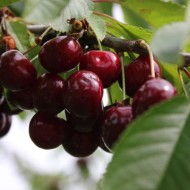The subtleties of growing early ripe cherries Iput: useful tips for gardeners
Content
- 1 The history of the origin of the Iput cherry
- 2 Video "Planting and caring for cherries"
- 3 Varietal characteristics of the plant
- 4 Advantages and weaknesses of the variety
- 5 General rules of agricultural technology
- 6 The main diseases and pests of the variety
- 7 Reviews of summer residents about Iput cherries
The history of the origin of the Iput cherry
A variety of early ripening period Iput was bred by breeders under the leadership of M. Kanshina. In 1993, sweet cherries were included in the State Register of Breeding Achievements. The variety is considered winter-hardy and bears fruit abundantly even on infertile soils.

Video "Planting and caring for cherries"
In this video, an expert will tell you how to plant cherries and take care of the tree.
Varietal characteristics of the plant
Before planting this crop, it is recommended that you familiarize yourself with its description. The sweet cherry, which is grown in the private plots of the northern regions of the country, is distinguished by its unpretentious care and high yield.

Botanical description of the tree
Iput is characterized by medium height and pyramidal shape. The tree is densely covered with foliage. The buds are large, oval in shape. The foliage is elongated, rich dark green color. The leaf plate is smooth, without pubescence. The inflorescences are large, white in color. Fruits are formed in a kind of "bouquets", which makes harvesting very easy.
Drought resistance and frost resistance
Sweet cherries are not drought-resistant, so they need abundant watering every 3-4 weeks. In the southern regions, the tree is watered twice a month. Watering one sweet cherry requires 60–70 liters of water.
As for frost resistance, the plant belongs to the most resistant varieties. Iput is able to withstand temperatures as low as -40 ° C.
Flowering and ripening periods
The buds usually bloom at the end of May. Each inflorescence forms 4-5 flowers of a snow-white color. The berries are fully ripe by the end of June. Cherry bears fruit every year.
For better fruiting, pollinating trees should be planted next to Iput. The best "neighbors" are the varieties Revna, Tyutchevka, Ovstuzhenka. In addition, cherries are an excellent pollinator for cherries.
Description and taste of berries
Ripe sweet cherries are dark red in color. The weight of one berry reaches 5 g, but often cherries ripen up to 10 g. The flesh of the fruit is tender, juicy and soft. The taste is sweet, with a pleasant sourness. The kernel of the berries is quite easily separated from the cherries.
Productivity and use of fruits
From about the fifth year of life, the Iput cherry begins to bear fruit regularly. The average yield per tree is about 35 kg. However, subject to all growing rules, this figure can be doubled.
Most often, the fruits of the Iput variety are consumed fresh. However, they often make a variety of jams, compotes, and preserves.
Cherry Iput contains a lot of vitamin C, so berries, along with lemon, will help fight seasonal colds.
Transportability and storage of crops
Due to the fact that the berries have a dense skin, the transportability of sweet cherries is quite high. However, the storage period of the harvested crop is short - no more than 5 days.
- The average yield of one tree is about 35 kg
Advantages and weaknesses of the variety
- stable fruiting;
- high yield rates;
- early ripening;
- immunity to many fungal diseases and pests;
- medium height of the tree, which makes harvesting easier;
- high indicators of the taste of berries.
- the onset of regular fruiting only in the 5th year;
- in case of excess moisture, the berries crack.
General rules of agricultural technology
To obtain a rich and high-quality harvest, experienced gardeners recommend following some rules of agricultural technology.
Choosing a place and seedlings
For planting, it is better to select seedlings with a closed root system. This will allow them to be planted not only in spring, but also in autumn. The planting material should be uniform, without wrinkled areas. In addition, the roots should be free of rot and mold.
The best place for planting a variety is considered to be an illuminated place, which must be reliably protected from wind and drafts. The soil should be nutritious, loose.
Landing time and scheme
Planting dates completely depend on the region of cultivation. In the southern regions, the tree can be planted both in autumn and spring. In the north, only spring planting is allowed. The main condition is that at the time of planting, the seedlings must be dormant.
The interval between the pits should be 3 m. The diameter of the recess is 1 m and the depth is 0.8 m. The upper layers of the soil are mixed with humus to increase the fertility of the soil. A stake is installed in the center of the recess, to which a seedling is subsequently tied. It is important to spread the root system of the plant over the entire area of the pit.

Increased yield
Crop care does not differ from other varieties, but it has certain characteristics.
Watering should be carried out during the following periods:
- before bud break;
- two weeks after blooming buds;
- 15–20 days before fruit ripening.
However, it is important to remember that excess water in the soil will cause the berries to crack.
In the first year after planting, the culture is fed with superphosphate. It should be distributed near the trunk circle, and after that the soil should be dug up. The next year, the tree is fed with manure.
The level of productivity is also influenced by regular weeding and loosening of the soil.
Formation and pruning of the crown
If there is no prominent shoot on the tree, then it must be formed independently. To do this, it is tied to the stake, and the rest are shortened so that they reach 25 cm in length. The next year, all the side branches are tied to the stake so that they grow at right angles. When the tree reaches 3 m in height, the upper shoot is pruned.
Preparing for winter
The variety is winter-hardy, but in the northern regions it is still recommended to cover the tree. For insulation, a frame is formed around the plant, onto which agrofibre is then pulled.
The main diseases and pests of the variety
Most often, the culture is susceptible to such diseases:
- rust;
- perforated spotting;
- coccomycosis.
Of the small pests, aphids and cherry weevils most often attack sweet cherries. To prevent infection, preventive treatments should be carried out with a solution of tar soap, wormwood, celandine. In the event of a disease, it is recommended to resort to the help of insecticidal preparations.
Reviews of summer residents about Iput cherries
The main evidence of the quality and fertility of the Iput variety is the numerous reviews of gardeners who have been growing the crop for more than a year.
“We have been growing Iput cherries for about 7 years. The culture bears excellent fruit - the berries are large and tasty. We use them fresh, because they simply do not remain before conservation. "
“Skorospelka Iput, in my opinion, is the best variety for the northern regions of Russia. I have been familiar with the variety for more than 10 years, during this time I have never had any problems. Except that sometimes I spray it for diseases. "
The variety has won the hearts of many summer residents. Iput is unpretentious in cultivation and will delight the gardener with an abundant harvest of sweet berries.



